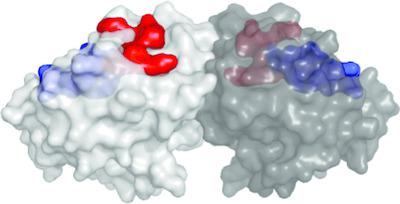当前位置:
X-MOL 学术
›
Acta Cryst. D
›
论文详情
Our official English website, www.x-mol.net, welcomes your
feedback! (Note: you will need to create a separate account there.)
Structural studies of geranylgeranylglyceryl phosphate synthase, a prenyltransferase found in thermophilic Euryarchaeota.
Acta Crystallographica Section D ( IF 2.6 ) Pub Date : 2020-06-04 , DOI: 10.1107/s2059798320004878 P N Blank 1 , A A Barnett 2 , T A Ronnebaum 1 , K E Alderfer 3 , B N Gillott 3 , D W Christianson 1 , J A Himmelberger 3
Acta Crystallographica Section D ( IF 2.6 ) Pub Date : 2020-06-04 , DOI: 10.1107/s2059798320004878 P N Blank 1 , A A Barnett 2 , T A Ronnebaum 1 , K E Alderfer 3 , B N Gillott 3 , D W Christianson 1 , J A Himmelberger 3
Affiliation

|
Archaea are uniquely adapted to thrive in harsh environments, and one of these adaptations involves the archaeal membrane lipids, which are characterized by their isoprenoid alkyl chains connected via ether linkages to glycerol 1‐phosphate. The membrane lipids of the thermophilic and acidophilic euryarchaeota Thermoplasma volcanium are exclusively glycerol dibiphytanyl glycerol tetraethers. The first committed step in the biosynthetic pathway of these archaeal lipids is the formation of the ether linkage between glycerol 1‐phosphate and geranylgeranyl diphosphate, and is catalyzed by the enzyme geranylgeranylglyceryl phosphate synthase (GGGPS). The 1.72 Å resolution crystal structure of GGGPS from T. volcanium (TvGGGPS) in complex with glycerol and sulfate is reported here. The crystal structure reveals TvGGGPS to be a dimer, which is consistent with the absence of the aromatic anchor residue in helix α5a that is required for hexamerization in other GGGPS homologs; the hexameric quaternary structure in GGGPS is thought to provide thermostability. A phylogenetic analysis of the Euryarchaeota and a parallel ancestral state reconstruction investigated the relationship between optimal growth temperature and the ancestral sequences. The presence of an aromatic anchor residue is not explained by temperature as an ecological parameter. An examination of the active site of the TvGGGPS dimer revealed that it may be able to accommodate longer isoprenoid substrates, supporting an alternative pathway of isoprenoid membrane‐lipid synthesis.
中文翻译:

香叶基香叶基甘油磷酸合酶的结构研究,这是一种在嗜热广古菌中发现的异戊烯基转移酶。
古细菌特别适合在恶劣的环境中繁衍生息,其中一种适应涉及古细菌膜脂质,其特征在于其类异戊二烯烷基链通过醚键与 1-磷酸甘油连接。嗜热和嗜酸广古菌热原体火山的膜脂完全是甘油二联植烷基甘油四醚。这些古菌脂质生物合成途径中的第一个关键步骤是在甘油1-磷酸和香叶基香叶基二磷酸之间形成醚键,并由香叶基香叶基甘油磷酸合酶(GGGPS)催化。本文报道了来自T. volcanium (TvGGGPS) 的 GGGPS 与甘油和硫酸盐复合物的 1.72 Å 分辨率晶体结构。晶体结构显示 TvGGGPS 是二聚体,这与螺旋 α5a 中不存在芳香锚残基一致,而其他 GGGPS 同系物中需要芳香锚残基进行六聚化; GGGPS 中的六聚四级结构被认为具有热稳定性。广古菌的系统发育分析和平行祖先状态重建研究了最适生长温度与祖先序列之间的关系。芳香锚残基的存在不能用温度作为生态参数来解释。对 TvGGGPS 二聚体活性位点的检查表明,它可能能够容纳更长的类异戊二烯底物,支持类异戊二烯膜脂质合成的替代途径。
更新日期:2020-06-04
中文翻译:

香叶基香叶基甘油磷酸合酶的结构研究,这是一种在嗜热广古菌中发现的异戊烯基转移酶。
古细菌特别适合在恶劣的环境中繁衍生息,其中一种适应涉及古细菌膜脂质,其特征在于其类异戊二烯烷基链通过醚键与 1-磷酸甘油连接。嗜热和嗜酸广古菌热原体火山的膜脂完全是甘油二联植烷基甘油四醚。这些古菌脂质生物合成途径中的第一个关键步骤是在甘油1-磷酸和香叶基香叶基二磷酸之间形成醚键,并由香叶基香叶基甘油磷酸合酶(GGGPS)催化。本文报道了来自T. volcanium (TvGGGPS) 的 GGGPS 与甘油和硫酸盐复合物的 1.72 Å 分辨率晶体结构。晶体结构显示 TvGGGPS 是二聚体,这与螺旋 α5a 中不存在芳香锚残基一致,而其他 GGGPS 同系物中需要芳香锚残基进行六聚化; GGGPS 中的六聚四级结构被认为具有热稳定性。广古菌的系统发育分析和平行祖先状态重建研究了最适生长温度与祖先序列之间的关系。芳香锚残基的存在不能用温度作为生态参数来解释。对 TvGGGPS 二聚体活性位点的检查表明,它可能能够容纳更长的类异戊二烯底物,支持类异戊二烯膜脂质合成的替代途径。











































 京公网安备 11010802027423号
京公网安备 11010802027423号